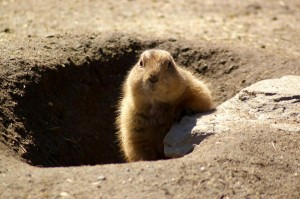This furry creature gains its fame from a holiday in its name and is very common in North America. Groundhogs are usually born in April or May and you may begin to see them in the following months. Though these animals can cause burrowing damage to your yard and eat your vegetables, an animal control company can easily remove them. Compiled below are interesting groundhog facts.

1. Groundhogs are rodents. Just like rats, mice, squirrels, and capybaras, groundhogs are rodents, all of which have gnawing habits.
2. Groundhogs live as far north as Alaska and as far south as Alabama. The groundhog population is likely higher now than before settlers reached North America and cleared forests, since there is much more burrowing space.
3. Groundhogs are clean animals. In fact they are resistant to plagues that wipe out other wild animal species, and a contributing factor is their cleanliness. They wipe their face after eating and lick their fur clean.
4. Groundhogs hibernate, hard! Groundhogs go into a very deep hibernation, like a coma, and their body temperature drops, blood flows very slowly, and breathing nearly stops.
5. Groundhogs help humans study hepatitis B- induced liver cancer. A portion of the groundhog population is infected with woodchuck hepatitis virus (WHV) and is one of the only species that scientists can study and compare to viral hepatitis in humans.
6. Groundhogs have helped reveal an archaeological site. Numerous artifacts have been found because of the burrowing activity of groundhogs at the Ufferman Site in Ohio.
7. Groundhogs do not drink water, usually. This is because groundhogs get most of their water content from the plants they eat and any rainwater collected on them.
8. Groundhog burrows can be huge. These critters dig burrows up to 5 feet underground with 46 feet of connected tunneling. It’s estimated that the average groundhog moves 5,500 lbs of soil when digging a burrow.
This final groundhog fact really points out why groundhogs are considered pests. Their burrows can cause significant structural damage to a home. Plus they can cause major damage to home gardens and farmer’s crops. If your yard is being overrun by groundhogs call animal control immediately.




